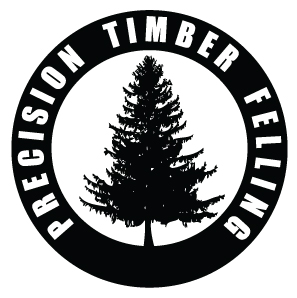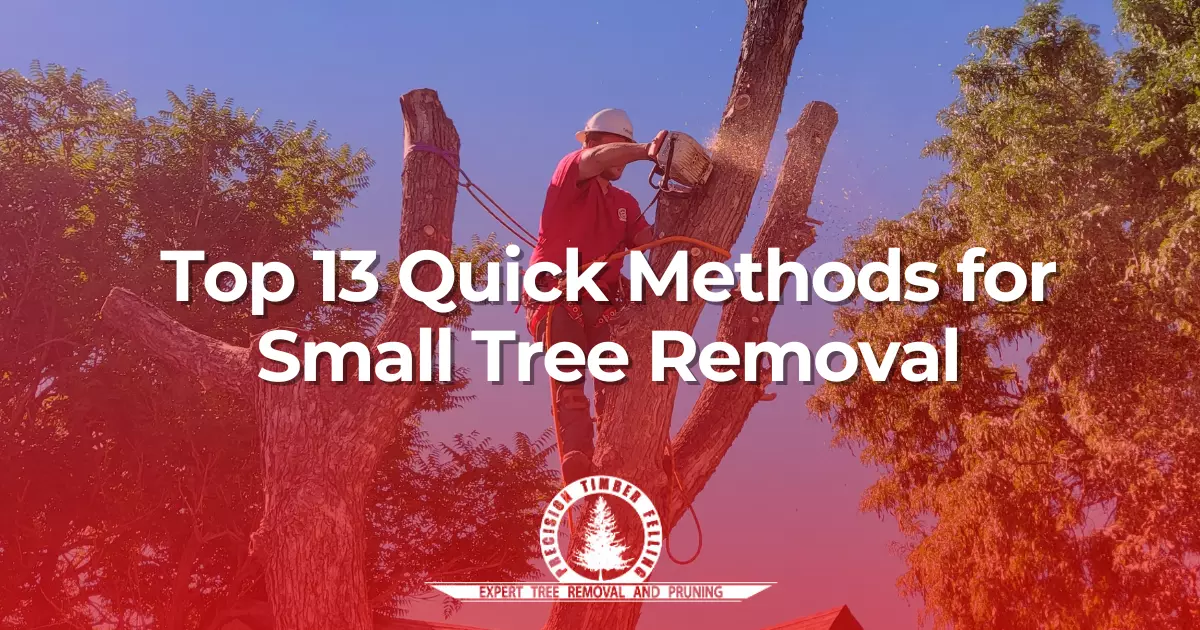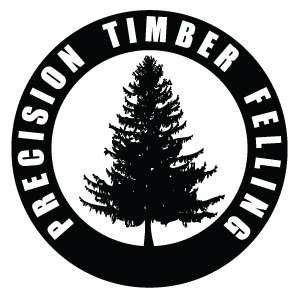13 Quick Methods for Small Tree Removal
Removing a small tree can be a daunting task, but it doesn’t have to be. Want to remove a dead tree, a palm tree, or a healthy tree that’s become a nuisance? Knowing the right methods can save you time and effort. This guide introduces you to the top quick methods for small tree removal.
From manual techniques to using proper equipment, we’ve got you covered. You’ll learn how to tackle tree trunks and tree stumps effectively. You can also save time in dealing with tall trees near power lines or smaller ones in your backyard.
Understanding the cost of tree removal and the average costs associated with different methods is crucial. This article will also provide insights into safe and efficient removal processes. This can make sure you’re well-equipped for any tree removal challenge. Dive in and explore the best strategies to clear your landscape quickly and safely.
What Tools Do You Need for Small Tree Removal?
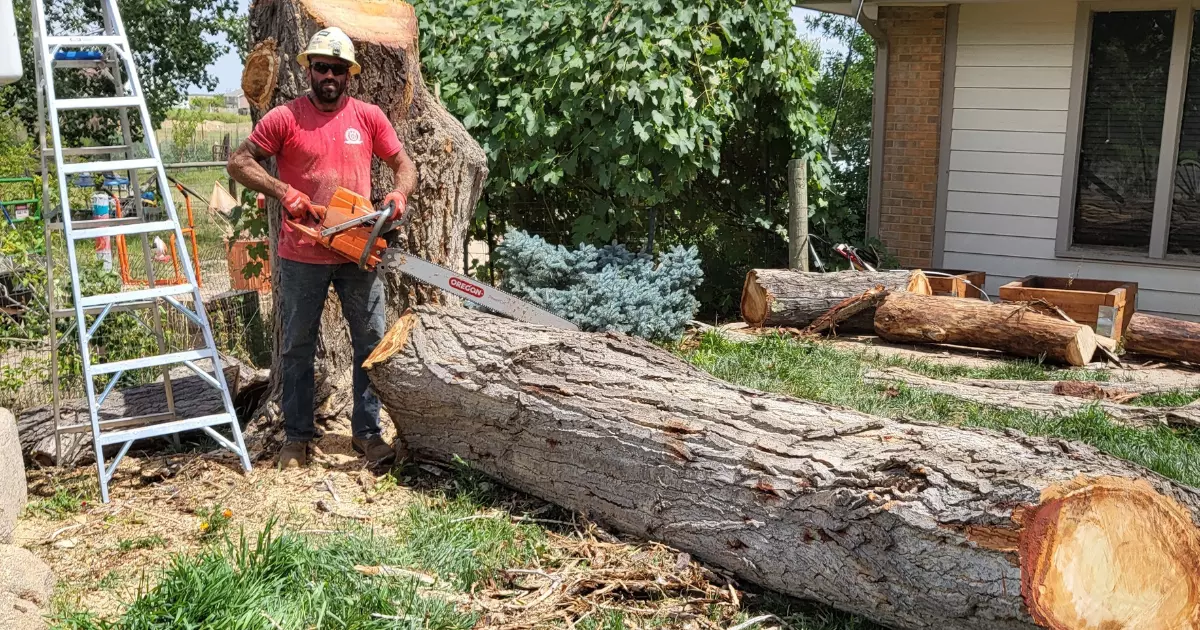
Each type of tree removal process requires specific equipment to ensure efficiency and safety. Dealing with dead branches from a diseased tree or the stump removal of a cedar tree? The correct tools will make the task manageable and minimize risks. Let’s dive into the specifics of each tool category needed for small tree removal.
Manual Removal Tools
Manual removal tools are the foundation of any tree removal process. These include a shovel, pickaxe, hand saw, and pruning shears. Each tool serves a unique purpose, from digging around the tree base to cutting dead branches. For smaller trees and minor tasks, these tools are often sufficient and cost-effective. Always ensure they are sharp and well-maintained to increase efficiency and reduce effort.
Cutting and Sawing Tools
Cutting and sawing tools are vital for dealing with larger trees and thick branches. A chainsaw is indispensable for cutting through thick tree trunks and larger branches. Hand saws and loppers are perfect for smaller, more precise cuts. The type of tree and its size will determine which cutting tools are necessary. Remember to follow safety precautions, such as wearing protective gear, to avoid accidents.
Digging Tools
Digging tools are crucial for removing the tree root system. A spade and mattock can help break up the soil and expose roots. A digging bar is excellent for prying up stubborn roots. These tools are especially useful for trees with deep or extensive root systems. Proper digging tools make the stump removal process more manageable and less time-consuming.
Root Removal Tools
Root removal tools are essential for eliminating a tree from your property. Tools like a root saw, grub hoe, and root slayer are designed to cut through tough root systems. These tools are particularly effective for older trees with extensive roots. Removing the roots helps prevent regrowth and ensures the tree is entirely gone. Investing in quality root removal tools can save you from the hassle of future tree care.
Chemical Tools
Chemical tools offer an alternative to physical removal methods. Tree and brush killers or herbicides can be applied to kill the tree and its roots. This method is useful for dealing with stubborn trees or when manual removal is not feasible. However, it’s essential to follow the instructions carefully to avoid harming surrounding vegetation. Chemicals can be an efficient way to deal with tree removal without heavy labor.
Mechanical Tools
Mechanical tools, such as a stump grinder or tree puller, are perfect for larger trees. These tools can significantly speed up the removal process. A stump grinder is particularly useful for grinding down the remaining stump after cutting down the tree. A tree puller can help remove the entire tree, including its roots. Mechanical tools might involve an additional cost but are worth it for their efficiency and effectiveness.
Safety Equipment
Safety equipment is non-negotiable in the tree removal process. Safety goggles, gloves, hard hats, and steel-toed boots protect you from potential injuries. Tree removal can involve safety hazards like falling branches and sharp tools. Wearing the proper protective gear minimizes the risk of accidents. Investing in quality safety equipment is a rule of thumb for any tree removal project.
Professional Assistance Tools
Sometimes, professional assistance tools are necessary, especially for emergency tree removal. Professionals use advanced tools like hydraulic stump grinders and heavy-duty chainsaws. These tools are expensive and typically not worth purchasing for one-time use. Hiring a tree removal company can provide access to these tools and expertise. It’s particularly beneficial for complex removals involving mature or expensive trees.
What are The Legal Considerations for Removing Trees?
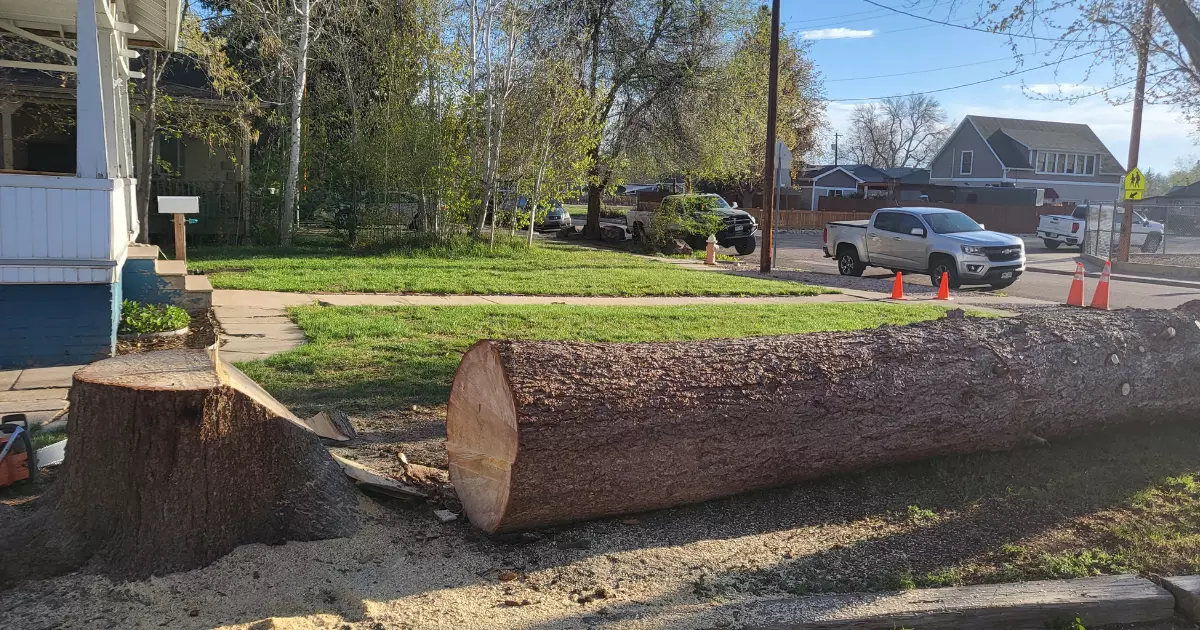
The laws and regulations are in place to protect you, your property, and the environment. Knowing the specifics can save you from hefty fines and potential legal issues. Let’s explore each of these legal aspects in detail to ensure your tree removal process is smooth and compliant.
Tree Removal Permit
Securing a tree removal permit is often the first step. Local ordinances may require permits based on the tree’s size, typically measured in inches in diameter, and its species. This process ensures that the removal doesn’t negatively impact the community or environment. Check with your local government to understand the requirements and fees. Failure to obtain the necessary permits can lead to significant fines and delays in your project. Check out our comprehensive guide to tree removal to learn more.
Tree Size and Type
The size and type of tree play a significant role in legal considerations. Larger trees or those of specific species, like mature oaks or heritage trees, may have additional protections. Regulations might require you to document the tree’s size and health status before removal. This ensures that only necessary removals are carried out, preserving valuable or protected trees. Always verify if the tree you plan to remove falls under any special categories.
Proximity to Structures
When a tree is close to structures, the removal process becomes more complex. Trees near property lines, buildings, or electrical wires require careful planning and adherence to safety regulations. The risk of property damage or personal injury increases significantly in these cases. Make sure to consult local guidelines on how to safely handle these removals. Professional assessment might be necessary to avoid potential liabilities.
Safety Precautions
Safety should always be a priority during tree removal. Wearing protective clothing, such as sturdy work boots and safety goggles, is essential to prevent injuries. Establishing an escape route and understanding the proper use of equipment like a wood chipper can mitigate risks. Following these safety precautions helps avoid medical bills and ensures a smooth removal process. It’s a rule of thumb to prioritize safety at every step.
Environmental Impact
Consider the environmental impact of your tree removal. Some areas have strict regulations on disposing of tree waste and protecting surrounding vegetation. Using eco-friendly methods and proper equipment can minimize damage to the ecosystem. Understanding these regulations can help you avoid additional costs and support sustainable practices. Always check local laws regarding environmental protection during tree removal.
Urgent Tree Removal
In emergencies, such as removing a diseased tree or dead branches, there may be expedited processes. Emergency tree removal often has specific legal stipulations to address immediate hazards. Ensure you understand the criteria for emergency removal to avoid unnecessary delays. Local authorities may provide guidelines on how to handle these urgent situations. Quick and compliant action is essential for safety and legal adherence.
Consultation and Professional Assistance
Sometimes, hiring a professional arborist or tree removal company is the best option. Professionals have the expertise and tools, like hydraulic stump grinders, to handle complex removals. Legal implications may require professional assessments or services. This ensures compliance with local laws and prevents property damage. Professional assistance can also offer additional services and save you from costly mistakes.
Additional Costs and Services
Be prepared for potential additional costs associated with tree removal. Permit fees, professional services, and compliance measures can add up. Understanding these costs upfront helps budget and avoid surprises. Additional services, such as stump removal or tree trimming, may also be necessary. Planning for these expenses ensures a smooth and hassle-free removal process.
Property Damage and Liability
Liability for property damage is a serious concern during tree removal. Ensure you have the necessary insurance coverage to protect against accidents. Proper planning and following safety guidelines can minimize risks. Consult with your insurance provider to understand your coverage. Taking these precautions protects you from financial and legal repercussions.
Compliance with Local Regulations
Local regulations and homeowner association rules must be followed during tree removal. These laws vary by location and can include specific guidelines for tree species, size, and removal methods. Ensure full compliance to avoid legal issues and fines. Research and adhere to these rules for a smooth process. Compliance is key to successful and legal tree removal.
What are The Methods for Small Tree Removal?
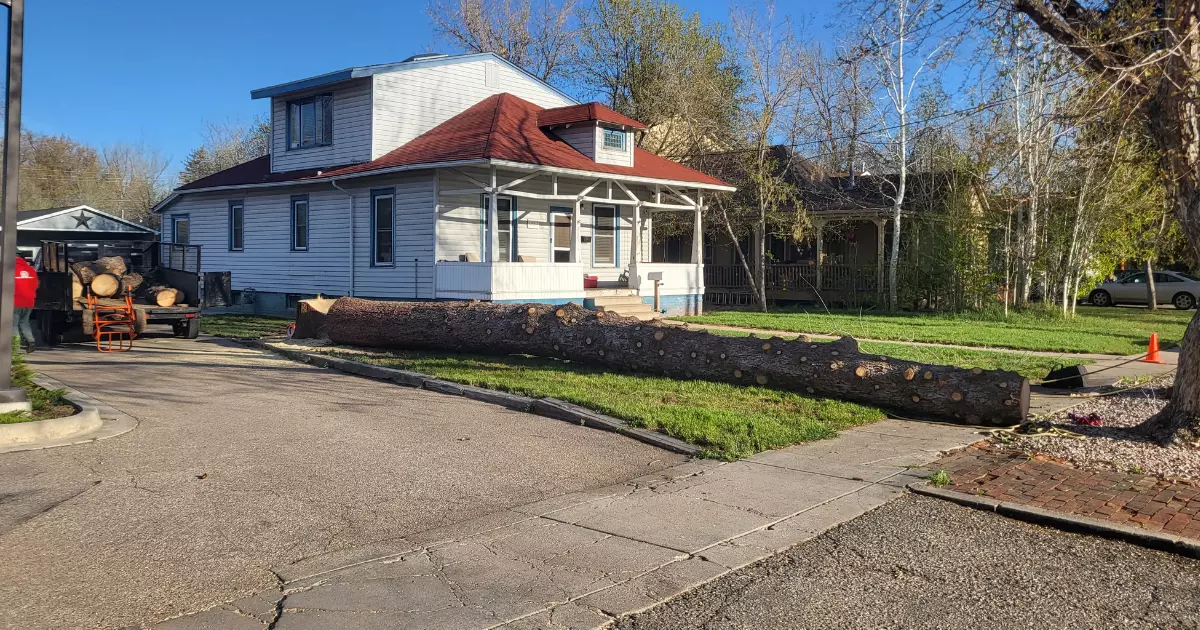
When it comes to small tree removal, knowing the best methods can save you time, effort, and money. Understanding these methods can help you choose the most effective strategy for your specific tree type and situation. Let’s explore the top 13 methods for small tree removal, providing you with the knowledge to tackle any tree removal challenge efficiently.
Method 1: Manual Tools
Manual tools are the simplest and most accessible way to remove small trees. Using tools like shovels, axes, and pruning shears, you can cut down the tree and dig up the roots. This method is cost-effective and requires no special equipment. However, it can be labor-intensive and time-consuming. It’s best suited for shorter trees with less extensive root systems.
Method 2: Root Removal
Root removal focuses on extracting the tree’s root system to prevent regrowth. This method involves digging around the tree to expose the roots and then cutting them out with a root saw or loppers. It’s useful for trees with secondary roots that can cause issues if left in the ground. Root removal ensures that the tree is entirely gone, but it can be challenging for mature trees with deep roots. It’s a thorough approach that eliminates potential hazards from leftover roots.
Method 3: Chemical Solutions
Chemical solutions offer an alternative to physical removal by using herbicides to kill the tree and its roots. Apply the chemical to the tree stump and surrounding area to ensure complete absorption. This method is effective for stubborn trees and can save labor. However, it requires careful handling to avoid harming nearby vegetation. It’s an efficient solution for tree removal when manual labor isn’t feasible.
Method 4: Stump Grinding
Stump grinding involves using a stump grinder to grind down the tree stump to below ground level. This method is efficient for removing the visible remains of a tree. It’s useful for trees with large stumps that are difficult to dig out. This leaves the area ready for replanting or other landscaping. It requires renting special equipment or hiring tree removal services.
Method 5: Pulling with Vehicles
Pulling a tree out with a vehicle can be a quick and effective method for small trees. Attach a strong rope or chain to the tree and the vehicle and slowly drive forward to uproot the tree. This method requires careful planning to avoid damaging nearby structures or power lines. It’s ideal for trees with shallow root systems. Ensure you have the right vehicle and safety precautions in place.
Method 6: Burning the Stump
Burning the stump involves setting the tree stump on fire to eliminate it. This method requires drilling holes into the stump, filling them with a flammable substance, and lighting it. Burning can be an effective way to deal with stubborn stumps but poses potential hazards. Ensure local regulations allow burning and take necessary safety precautions. It’s a method that works well in open areas with no nearby structures.
Method 7: Leveraging Winches
Using a winch can help pull out a small tree with controlled force. Attach the winch to the tree and a stable anchor point, then crank the winch to uproot the tree. This method is useful for trees with stronger root systems that are difficult to pull by hand. It provides more control and reduces the risk of property damage. Winches are available for rent or purchase and are a valuable tool for tree removal.
Method 8: Professional Services
Hiring professional tree removal services ensures the job is done safely and efficiently. Professionals have the experience and equipment to handle all types of trees, from mature oak trees to smaller saplings. They can also manage potential hazards, such as proximity to power lines or nearby structures. While this method incurs additional costs, it guarantees a thorough and hassle-free removal process. It’s the best option for complex or high-risk tree removals.
Method 9: Digging Out
Digging out the tree involves excavating the area around the tree to remove the entire root ball. This method requires digging a trench around the tree and using shovels and spades to lift it out. It’s effective for removing the entire tree, including roots. This method is labor-intensive and best suited for smaller trees or those with less extensive root systems. It ensures the tree is completely removed, preventing regrowth.
Method 10: Using a Backhoe
Using a backhoe for tree removal is ideal for larger trees or when dealing with multiple trees. The backhoe can dig around the tree and lift it out of the ground. This method is quick and efficient but requires access to heavy machinery and an experienced operator. It’s perfect for larger projects or when dealing with mature trees. Renting a backhoe or hiring a service can increase the overall cost but saves significant labor.
Method 11: Cutting and Sectioning
Cutting and sectioning the tree involves cutting the tree into manageable sections for easier removal. Start by cutting down the main trunk and then sectioning the larger branches and stump. This method makes it easier to transport the tree pieces and handle the removal process. It’s useful for trees located in confined spaces where whole tree removal isn’t feasible. Ensure you follow safety guidelines to avoid injury during cutting.
Method 12: Natural Decay
Allowing the tree to naturally decay is a low-effort removal method. Cut the tree down and leave the stump to decompose over time. This method takes patience as it can take several years for the stump to fully decay. It’s a cost-effective solution if immediate removal isn’t necessary. Accelerate the process by applying decay-accelerating chemicals or creating conditions conducive to rot.
Method 13: Replanting Strategies
Replanting strategies involve replacing the removed tree with new vegetation. After removing the tree, prepare the soil and plant a new tree or plants in its place. This method helps maintain the landscape’s aesthetic and supports environmental health. Choose tree species suitable for the area and consider the mature height to avoid future removal issues. Replanting provides a sustainable solution to tree removal.
What are The Common Mistakes to Avoid When Removing Trees?
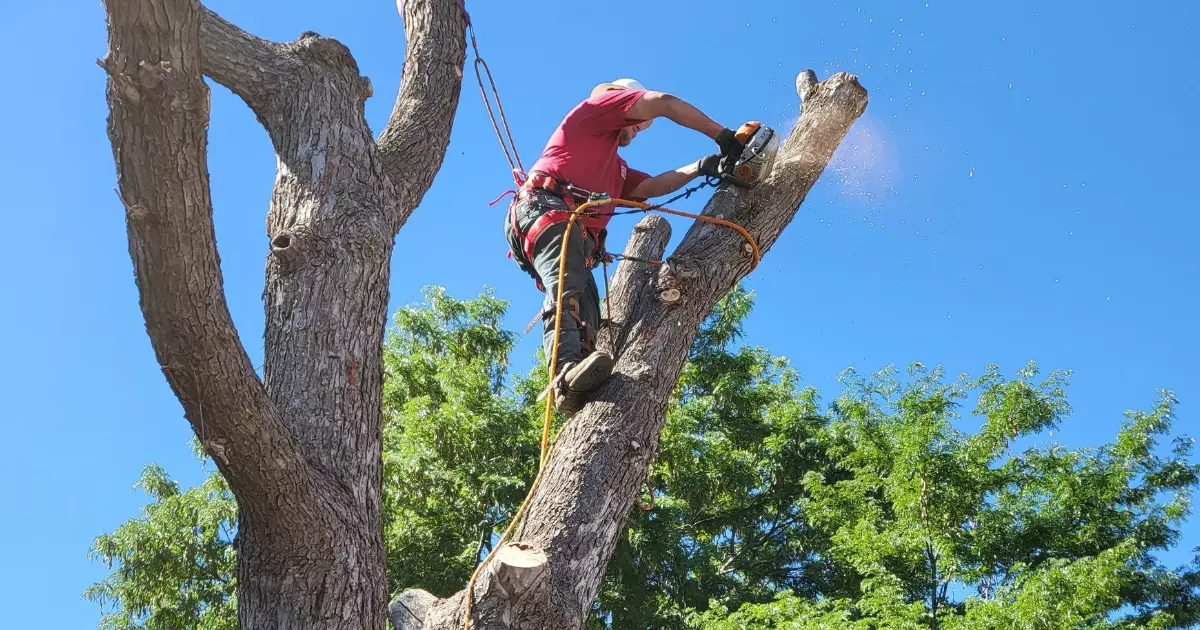
Overestimating your ability to handle larger trees without professional help can lead to property damage and high tree removal costs. Let’s explore these mistakes in detail to ensure a safe and efficient tree removal process.
Ignoring Proximity to Power Lines
Trees near power lines require special attention. One wrong move can cause electrical accidents or power outages. Always assess the tree’s proximity to these lines before starting. If the tree is too close, it’s best to hire professionals who have the expertise and equipment to handle it safely. Avoiding this mistake can prevent serious injuries and property damage.
Failing to Use Proper Equipment
Using the right equipment is crucial for safe tree removal. Sturdy work boots, safety goggles, and protective clothing are essential to protect yourself from injuries. Tools like chainsaws, wood chippers, and root saws should be in good working condition. Neglecting to use proper equipment can lead to accidents, resulting in medical bills and added costs. Ensure you have all the necessary gear before beginning the removal process.
Overestimating Your Ability
Taking on large tree removal without professional help can be risky. Mature trees, especially those with extensive root systems, require expertise and specialized tools. Attempting to remove these trees on your own can lead to property damage or personal injury. It’s important to recognize when a tree removal service is needed. Professionals can safely and efficiently handle complex removals, saving you time and potential hazards.
Not Securing a Tree Removal Permit
Skipping the permit process can result in legal issues and fines. Many areas require a tree removal permit, especially for certain tree species or sizes. Check local regulations to determine if you need a permit. Obtaining the necessary permits ensures you are compliant with local laws. This step can save you from unexpected fines and delays in your project.
Neglecting Safety Precautions
Safety should be a top priority in tree removal. Establishing an escape route, understanding the tree’s fall direction, and using safety gear can prevent accidents. Ignoring safety precautions can lead to severe injuries or property damage. Always plan and prepare for potential risks. Following these safety measures ensures a smoother and safer tree removal process.
What are The Best Times of The Year for Small Tree Removal?
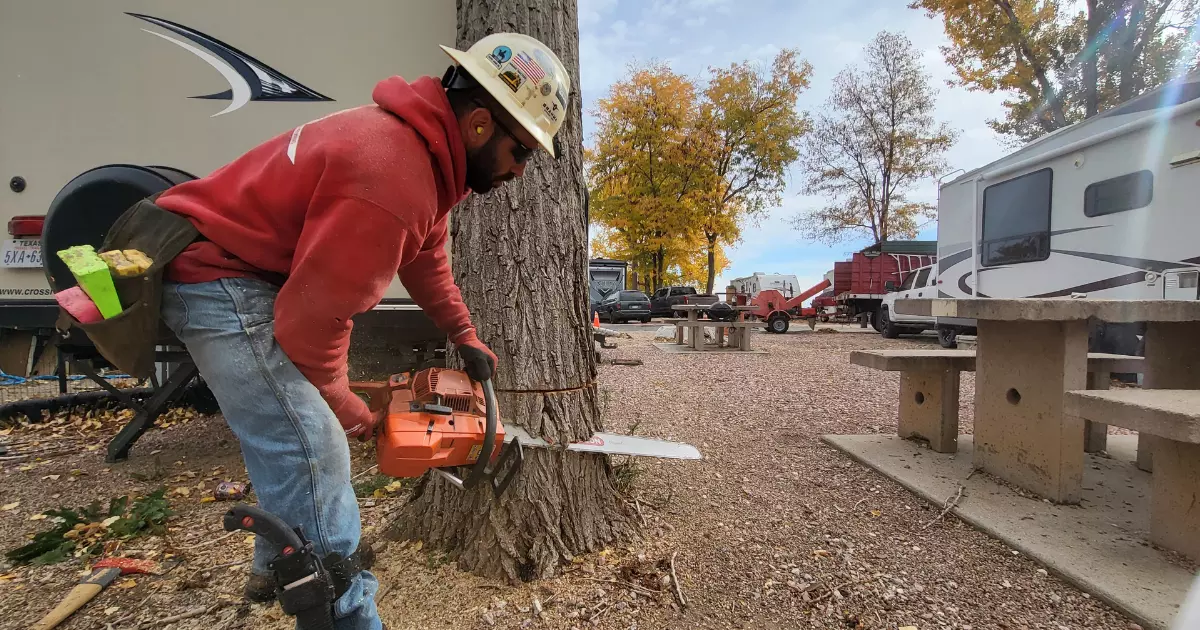
Timing is crucial when it comes to removing small trees. The best times of the year for small tree removal are during the late fall and early spring. During these periods, trees are dormant which makes them easier to cut down and handle. Removing trees in late fall avoids disrupting their active growth phase. Cooler weather can make physical labor more manageable.
Early spring is ideal before new growth begins. It allows clear visibility of the tree’s structure and minimizes impact on surrounding plants. Avoiding the peak growing seasons helps reduce regrowth and ensures a smoother, more efficient removal process.
Wrapping Up
Removing small trees requires careful planning and the right approach to ensure safety and efficiency. From using manual tools to professional services, each method has its benefits and is suited to different situations. Understanding the legal considerations and avoiding common mistakes can prevent costly fines and ensure a smooth removal process. Choosing the best time of year for tree removal can further enhance the ease and success of the task.
Ready for tree removal, stump grinding, or junk removal and hauling? Precision Timber Felling offers precision and care to guarantee a safe, clean, and beautiful property. We prioritize customer satisfaction and environmental integrity which makes us the best choice for your needs. Contact us at +1 9702181620 today to experience the difference and take the first step toward a well-maintained property.
